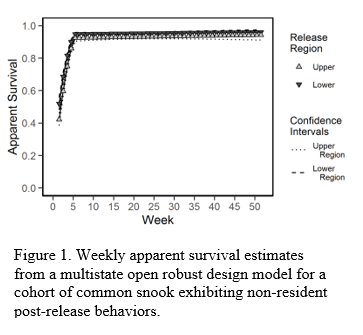TIMELY ESTIMATION OF POST-RELEASE SURVIVAL FOR HATCHERY-REARED JUVENILE FISHES: APPLICATION TO COMMON SNOOK Centropomus undecimalis
Effective adaptive management of aquaculture-based fisheries enhancement programs requires timely estimation of the impact of stocking activities. For estuarine finfishes, post-release survival estimation may be particularly challenging due to low recapture rates. In southwest Florida, aquaculture-based enhancement has been explored to aid population recovery of common snook (Centropomus undecimalis) after mass mortality events due to cold stuns and red tide because snook support a valuable recreational fishery. To guide effective snook enhancement, we apply a novel approach for release activities of hatchery-reared juveniles to guide timely estimation of post-release survival.
Following replicate weekly release designs, juvenile snook marked with passive integrated transponder (PIT) tags have been used in hypothesis-driven release experiments to identify the influence of release locations, times, and procedures on post-release survival and behavior. Stocked snook are monitored with marine-adapted PIT tag antenna arrays that generate recapture histories that inform multistate mark-recapture models after 1 year of post-release monitoring.
Short-term differences in survival among the first few weeks after release primarily influence the overall impact of stocking activities (e.g., Figure 1), but fish size, tag size, pre-release acclimation to habitat, environmental conditions at release sites, the use of predator-exclusion cages, and residency behaviors of hatchery-released fish have influenced survival and detectability. The highest survival rates have been observed for individuals released in lower reaches of tidal creek systems in the spring, indicating these areas may provide ideal release sites for juvenile snook at that time.
Further identifying optimal release locations, times, and procedures will promote adaptive management of enhancement programs and maximize the impact of informed, strategic stocking on receiving populations.
